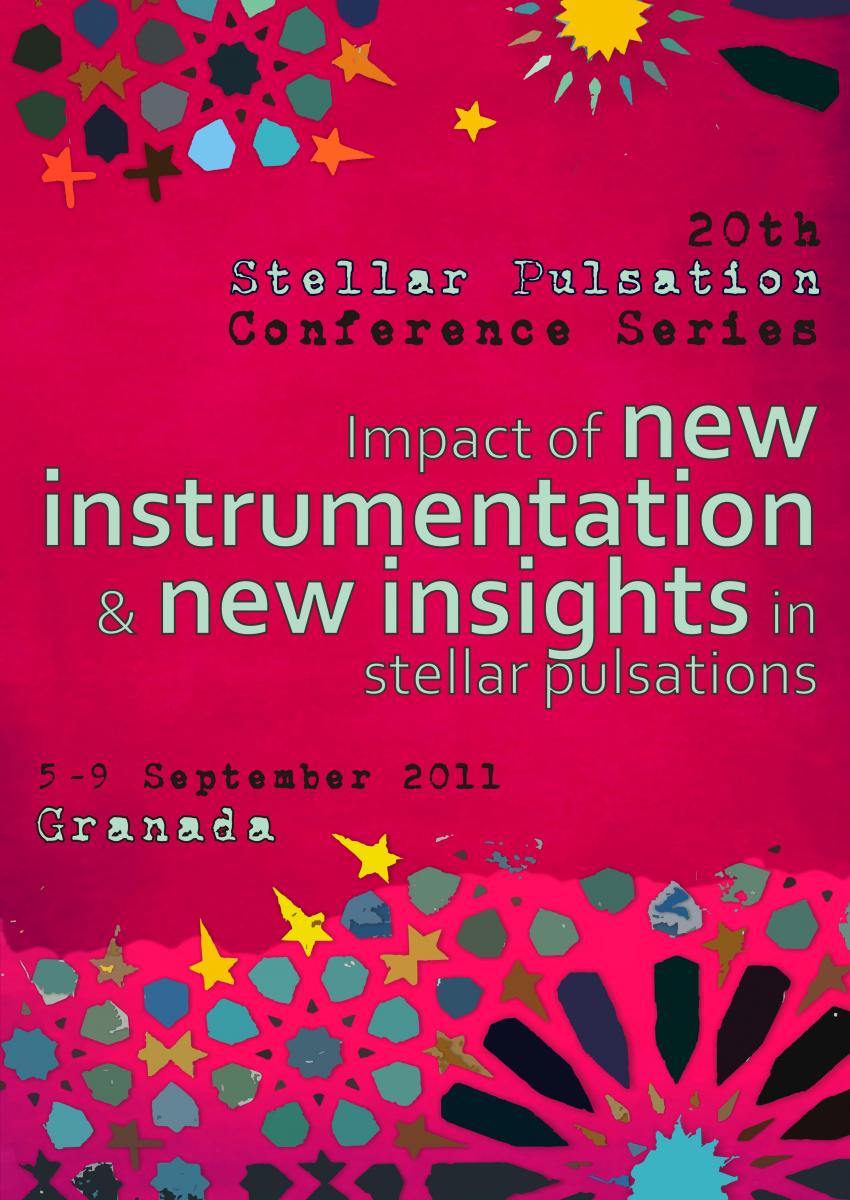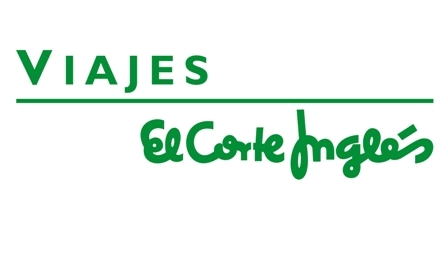Scientific program
The abstracts book is available here.
Program scheme
Sessions will start around 9h and will finish around 18h30 with two hours for lunch in between from 13h to 15h approximately. On Wednesday 7th September, there will be no sessions in the afternoon. The conference will finish on Friday 9th around 14h.
Monday 5 September
Session 1 "The poor agreement between observed and predicted frequencies":
Why is so difficult to match predicted and observed oscillation frequencies for most stars? Is theory the only responsible? Might the observation technique be also responsible? In this session, discussion will be opened within two different approaches to the same physical phenomenon.
|
SESSION Ia - 9h-12h55
|
||
|
Welcome
|
J.C. Suárez
|
20’
|
|
Stellar pulsations and stellar evolution: conflict, cohabitation, or symbiosis?
|
A. Weiss
|
45’
|
|
3D Simulation of the Interaction of Radial Pulsation and Convection
|
C. Geroux
|
20’
|
|
Physics of the solar twin: the example of 18 Sco
|
M. Bazot
|
20’
|
|
Vibrational Instability of metal-poor low-mass main-sequence stars
|
T. Sonoi
|
20’
|
|
Coffee Break (30')
|
||
|
Non-radial pulsation and magnetic fields of OB stars
|
N.P. Sudnik
|
20’
|
|
Pulsations in hot massive stars
|
C. Lovekin
|
20’
|
|
On the origin of the dense frequency spectra of space observed intermediate mass pulsating stars
|
J. Pascual-Granado
|
20’
|
|
The photometric & spectroscopic behavior of classical pulsators in the instability strip
|
E. Poretti
|
20’
|
|
Lunch
|
||
|
SESSION Ib - 15h-18h15
|
||
|
Open questions in seismology of rapidly rotating stars
|
F. Lignières
|
45’
|
|
Pulsations of rapidly rotating evolved stars
|
R. Ouazzani
|
20’
|
|
Traditional approximation for low-frequency modes in rotating stars
|
H. Shibahashi
|
20’
|
|
Coffee Break (30')
|
||
|
Modeling stellar convection & pulsation in multidimiensions using ANTARES code
|
H.J. Muthsam
|
20’
|
|
Regular modes in rapidly-rotating stars
|
M. Pasek
|
20’
|
|
Periodicities in the frequency spectra of delta Scuti stars
|
A. García Hernández
|
20’
|
|
Oscillation spectra and fast rotation
|
F. Peña
|
20’
|
Tuesday 6 September
Session 2 "Giant stars"
Recent progress on Giant stars, in particular the presence of both radial and non-radial oscillations in such stars, deserve specific attention.
|
SESSION IIa - 9h-12h35
|
||
|
Asteroseismology of red giants
|
J. De Ridder
|
45’
|
|
Mean large frequency separations of read giants: By how much do estimates vary depending on the selected frequency range?
|
S. Hekker
|
20’
|
|
Some thoughts about the Blazhko effect for RR Lyrae variable pulsations
|
A. Cox
|
20’
|
|
Period doubling in Kepler Blazhko RR Lyrae stars
|
R. Szabo
|
20’
|
|
Coffee Break (30')
|
||
|
First detection of period doubling in a BL Herculis type star. Observations & theoretical models
|
R. Smolec
|
20’
|
|
The projection factor of Cepheids
|
N. Nardetto
|
20’
|
|
New links between pulsation and stellar history
|
N. Evans
|
20’
|
|
Evidence of pulsation-driven mass loss from delta Cephei
|
M. Marengo
|
20’
|
|
Lunch
|
||
|
SESSION IIb - 15h-17h55
|
||
|
Multiperiodic oscillations in Cepheids & RR Lyr-type stars
|
P. Moskalik
|
45’
|
|
RR Lyrae studies with Kepler
|
K. Kolenberg
|
20’
|
|
The nature variability in M supergiants: the forgotten type C semiregulars
|
D. Turner
|
20’
|
|
Coffee Break (30')
|
||
|
Pulsational light variability in post-AGB stars in the Milky Way Galaxy & the Large Magellanic Cloud
|
B. Hrivnak
|
20’
|
|
A testimator approach to detecting heteroskedasticity in the Cepheid PL relation
|
S. Kanbur
|
20’
|
|
Synthetic Cepheid Period-Luminosity Relations in the IRAC Bands
|
C.C. Ngeow
|
20’
|
Wednesday 7 September
Session 3 "New instrumentation from the ground and space"
Space missions like SOHO, MOST, CoRoT & Kepler, as well as new ground-based instrumentation have been (and are being) built in order to attain very high precision of the asteroseismic data required. Do the results fulfill the expectations? A controversial example might be the g modes in the Sun and other stars. In this session, latest and relevant results of space missions and ground-based instrumentation will be presented. As well, we will discuss the relevance and necessity of new techniques and instrumentation.
|
SESSION III - 9h-13h40
|
||
|
New ground-based observational methods and instrumentation for asteroseismology
|
P. J. Amado
|
45’
|
|
Impact of high precision photometry in space
|
E. Michel
|
45’
|
|
VOTA: A virtual Observatory tool for asteroseismology
|
E. Solano
|
20’
|
|
Coffee Break (30')
|
||
|
Long-baseline interferometric observations of Cepheids
|
P. Kervella
|
20’
|
|
Life after Kepler
|
W. Weiss
|
20’
|
|
Programs & perspectives of visible long baseline interferometry: VEGA/CHARA
|
D. Mourard
|
20’
|
|
Spectro-inteferometry studies of velocity-related phenomena at the surface of stars: pulsation & rotation
|
A. Mérand
|
20’
|
|
The Vista variables in the Via Lactea ESO public Survey: Current status and First results
|
M. Catelan
|
20’
|
|
Solar-like stars observed by Kepler: an incredible adventure
|
R. García
|
20’
|
| First evidence for solar-like oscillations in a Delta Scuti star | V. Antoci | 20' |
|
Free afternoon / Night Alhambra Visit
|
||
Thursday 8 September
Session 4 "Mode identification"
Mode identification, either individual or by means of regular patterns, is crucial for asteroseismology. Despite the progress on this issue during the last decades, the comparison between observations and models remains unclear. This session is devoted to the main problems and prospects of empirical and theoretical approaches for the mode identification.
|
SESSION IV - 9h-13h
|
||
|
Identification of pulsation modes in main sequence pulsators: uncertainties and limits
|
A. Pamyatnykh
|
45’
|
|
Uncovering hidden modes in RR Lyrae stars
|
L. Molnár
|
20’
|
|
Complex asteroseismology of the slowly pulsating B-type star HD74560
|
P. Walczak
|
20’
|
|
Coffee Break (30')
|
||
|
First evidence of pulsations in Vega: Results of today’s most extensive spectroscopic research
|
T. Böhm
|
20’
|
|
Theoretical properties of regular spacing in the oscillation spectra of delta Scuti stars
|
J.C. Suárez
|
20’
|
| Theoretical approach to mode identification | J. Guzik | 45’ |
|
Diagnostic tools for solar-like stars
|
I. Roxburgh
|
20’
|
|
Towards a precise asteroseismology of solar-like stars
|
A. Grigahcène
|
20’
|
|
Lunch
|
||
Session 5 "Oscillations vs Activity plus planet transits"
Activity and rotation are two physical phenomena that might mimic stellar oscillations (or viceversa). In any case, all these phenomena are exhibited simultaneously by the star, and need to be disentangled. This includes the presence of planets transiting the host star.
|
SESSION V - 15h-18h25
|
||
|
Current state of the modeling of photospheric activity
|
A. F. Lanza
|
45’
|
|
Pulsating stars harboring planets
|
A. Moya
|
45’
|
|
Succesful asteroseismology for a better characterization of the exoplanet HAT-P-7
|
M. Oshagh
|
20’
|
|
Coffee Break (30')
|
||
|
The new Kepler picture of variability amongst A and F stars
|
K. Uytterhoeven
|
20’
|
|
Stellar activity cycles and contribution of the deep layers knowledge
|
S. Mathur
|
45’
|
|
Conference Dinner
|
||
Friday 9 September
Session 6 "Early type stars. Oscillations vs other agents (mainly regular/rotational variations of B stars)"
The particular phenomenon of B stars is one of the most controversial nowadays in the field. In this session, two different views of the problem will open the discussion
|
SESSION VI - 9h-13h30
|
||
|
The Be stars puzzle
|
L. Balona
|
45’
|
|
Be stars: rapidly rotating pulsators
|
T. Rivinius
|
45’
|
|
A pulsational study of a sample of CoRoT faint Be stars
|
T. Semaan
|
20’
|
|
Coffee Break (30')
|
||
|
Mode identification of subdwarf B stars with Kepler data
|
M. Reed
|
20’
|
|
Pulsating pre-main sequence stars in NGC 2264 discovered by the MOST and CoRoT satellites
|
K. Zwintz
|
20’
|
|
Constraints on Pasta structure of neutron stars
|
H. Sotani
|
20’
|
|
Whole Earth Telescope observations of EC14012-1446: Convection in DA white dwarfs
|
J.L. Provencal
|
20’
|
|
Asteroseismology of a V777 Her pulsator observed by Kepler
|
R. Østensen
|
20’
|
|
Conclusions
|
(tbd)
|
30’
|
Context and Scope
Is Asteroseismology close to really unveil the internal structure of stars? Do we need to reconsider the observational techniques, data analysis and/or to develop new theoretical approaches? After the recent results of space photometic light curves, is really meaningful the current classification of pulsating stars? Which are the primary unsolved problems that Asteroseismology must solve to make a step forward in understanding stellar evolution?
The present edition of the Stellar Pulsation Conference Series is intended to tackle these and other unsolved problems in stellar seismology.
Sessions, Talks & Discussion
In this context, the conference will be organized in six sessions distributed in four and a half days. Each session has a guiding topic (those given here below are orientative) which put in context one or several issues to be discussed in the session.
Invited speakers will present their personal view about the topic of the corresponding session. In order to encourage discussions on controversial points, round tables after each session will be organized.
Posters viewing will be available permanently. No specific session for poster viewing/presentation is foreseen.


